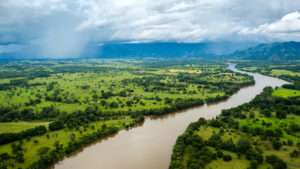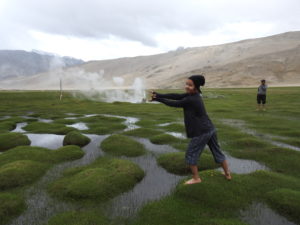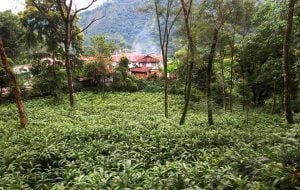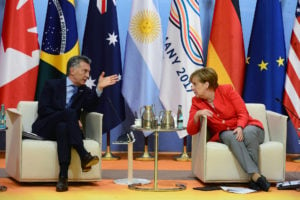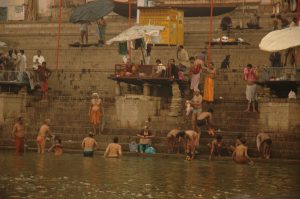This is the fourth article in a special series examining China’s role in promoting peaceful and sustainable development in Colombia in the context of the peace process
Though just three metres wide stretching across a small ravine, ‘Resistance Bridge’, which connects a dilapidated road in a remote rural part of the southern Colombian department of Caquetá, has become a symbol of the tension between Chinese state oil company Sinochem and local communities adamantly opposed to their project.
Following three years of poor relations with the farmers of the region, in April this year Emerald Energy – a subsidiary of Sinochem in Colombia – requested an environmental licence to start exploration of the Nogal block, located at the gates of the Amazon in a key area for post-conflict Colombia.
However, the level of social and environmental conflict throughout Caquetá, which is higher than the Colombian government is prepared to admit, means it’s very likely that the Chinese oil company will be left without a ‘social licence’ – the approval of companies and their projects by local communities. This also makes confrontations more likely.
This situation represents a paradox for the government of President Juan Manuel Santos: it needs the revenues generated by extractive industries to finance the implementation of the Peace Agreement with the Revolutionary Armed Forces of Colombia (FARC), but the sector has faced increasing social opposition since its signing in November 2016.
From a bridge to a regional anti-oil movement
In May and June 2015, farmers in the Valparaíso municipality blocked the bridge allowing Emerald employees access to the settlements of La Florida and La Curvinata, where they carried out studies.
The blockade, which lasted 58 days, ended badly. The Colombian riot police (ESMAD) arrived to clear the road and, in the midst of resistance from communities, pelted protestors with tear gas. This resulted in 13 injured, three of them seriously. One was hospitalised for three weeks with a cracked skull.
The episode had a domino effect. Local communities in the neighbouring towns of Valparaíso (11,000 inhabitants) and Morelia (4,000 inhabitants) began to organise. They created ‘Committees for the Defence of Water’, to accommodate leaders and social organisations opposed to the entry of oil companies.
Videos of the bridge confrontation went viral, hence it becoming known as ‘Resistance Bridge’. In Florencia, this planted the seed for a regional movement that took shape against extractive industries – the Departmental Committee for the Defence of Water and Land, which today comprises peasant, political, academic, religious and business leaders. This issue quickly became part of Caquetá’s public agenda, with marches in defence of water that brought together thousands of people. Local committees sprung up in almost all municipalities of the department.
Why did the conflict escalate so quickly? What caused these communities to mobilise? The stories are different in each community, but the patterns repeat themselves. In Florencia, all accuse the company (in this case Emerald) of having acted with a lack of transparency in their planning, and even lying. They rely on the argument that their project is of public interest and a priority for the national Government.
“In 2014, we heard them talking about so-called ‘socialisation’ [a process of internalising the norms of a community within the planning process of a project], which we feel is an imposition,” says José Antonio Saldarriaga, a slender Valparaíso farmer, and one of the most visible social leaders. “Their message was that “they had the rights to the subsoil by virtue of possessing the [land] title, and that no one could reverse that. There was nothing for us to do there but to open doors for them.”
In 2015, opponents say that when they met with then interior minister Juan Fernando Cristo, a document appeared claiming they had apparently collectively endorsed the project. But they claim any signatures were actually for refreshments they received that day. Also, the company insisted it had no land of their own there, despite it purchasing a 30-hectare plot in the La Curvinata area.
Communities say that on one occasion, the Mayor’s Office summoned them to discuss a housing project, but they were actually met by Lorena Cortés, Emerald’s director of social relations, and a representative from environmental consultancy Cyma, who tried to get their approval for the environmental impact assessment.
The case of Herney Bermeo, an anaesthesiologist from Florencia whose farm is in the Yumal district, is even more noteworthy.
Emerald employees came to look for Bermeo at the hospital where he works to ask for permission to carry out studies on his farm. Bermeo told them that he was not interested in offers for his land but officials of the oil company visited without prior warning and entered the property by force, accompanied by the Army, he claims.
“I never gave them permission, nor did I sign anything. Sometime later, the groundskeeper called me and told me that they were erecting quadrants and carrying out a seismic study. I even talked to them on the phone and they told me they had a legal permit. No one notified me, nor did I see the permit. I hired a lawyer and filed a lawsuit, as a means of creating a precedent,” Bermeo says, adding that this year an allocation of 1.8 million Colombian pesos (US$ 600) from the company appeared on his income tax return, a sum that he never received and which he is still trying to track.
“You can see the company’s arbitrary actions and their abuses. Their only interest is to carry out their study, regardless of whether or not you give them permission. They are a law unto themselves,” he adds.
Diálogo Chino could not verify these incidents with other sources, but they illustrate why relations between Emerald and the communities have broken down. So much so, that since the blocking of the bridge, communities swore not to meet with the company again.
Sinochem declined to be interviewed about the project and its relations with local communities: “Unfortunately at this time we cannot accept your invitation [for an interview]. Perhaps in the future we will be able to do so,” Juanita Latorre, their administrative coordinator in Colombia, responded to our request by e-mail.
No formula for dialogue
Tensions settled somewhat when Emerald no longer had a presence in these rural areas, but are now escalating again as a result of the oil company’s request for an environmental license to begin exploration.
On April 19 this year, Emerald Energy asked the National Environmental Licensing Authority (ANLA) for permission to build 10 well platforms in the municipalities of Valparaíso, Morelia and Milán, in order to find out how much oil there really is. The idea – according to their environmental impact assessment – is to build five wells on each platform to drill somewhere between 1 and 2 kilometres deep to assess quantities of ground water.
The farmers of Valparaíso asked ANLA for a public hearing as part of the decision-making process, which was supported by 700 signatures. The national environmental agency has already approved the hearing, which at the time of writing has no date but is expected within the next three months. A licensing process in Colombia for a complex project can take between six months and a year.
Communities’ main concern is water.
“We live off the earth. We are cattle ranchers and farmers and we need water for both of these. That is what scares us,” says Jesús Alfredo Gómez, a leader from the San Marcos district in Morelia, whose livelihood depends on plantain, cassava and cane cultivation.
Luis Eduardo Ortiz, a farmer from Valparaíso whose farm falls within the area identified in the exploration license, says: “There has never been clear information about the possible impacts. They only talked about the economic benefits: roads and schools. Wastewater management only came to the fore two years later when we demanded it, but we are still uneasy.”
Communities plan to carry out their own environmental study, which they feel can counterbalance the one presented by Sinochem.
“The idea was to have an alternative scientific and technical study that can be compared with the company’s impact assessment and which can be presented to the ANLA to see if the company’s facts are indeed realistic or if there are gaps,” says Yolima Salazar, Director of the Southern Vicarage, the social branch of the Catholic Church in Caquetá, which has been involved in the process.
The study, funded by Caritas, the non-governmental organisation (NGO) of the German Catholic Church which has supported several of the Southern Vicarage’s projects, was carried out by Bogota’s Terrae Geo-environmental Corporation and led by Julio Fierro, a geologist who has worked in many public bodies including the Ministry of the Environment.
Fierro’s involvement will surely generate apprehension in the oil sector. In the past he has spearheaded highly critical studies in previous roles at the Office of the Comptroller General under its management by prominent lawyer Sandra Morelli. Fierro has been harsh in other writings on the extractive industry.
A central concern in the communities’ alternative study is Caquetá’s ‘pretty monkey’ (also known as the Caquetá titi monkey), a small red-haired primate, endemic to the region and only discovered in 2010. It is so rare that the monkey is classified as ‘critically endangered’, the most serious threat level identified by the International Union for the Conservation of Nature’s (IUCN) Red List of Endangered Species. Last year, the International Primatological Society included it in the list of the 25 most threatened primates in the world.
“That list shows a betrayal. They are the species closest to extinction, and therefore it should be a priority for the country to prevent them from dying out,” says Javier García, a biologist from Caquetá who teaches at the University of the Amazon. Garcia is one of the scientists who discovered the monkey.
The monkey only lives in a small triangle demarcated by the Caquetá and Orteguaza rivers, and three smaller streams connected to each other. The northern corner of that triangle, where the Pescado River feeds into the Orteguaza is precisely where Emerald is requesting the license to build the wells.
Communities believe the oil company is down playing the importance of the species. In the environmental assessment, it does not mention the monkey’s level of vulnerability and says that its “status should be verified since during the course of the EIA wildlife monitoring, their presence was not confirmed”.
“In the conservation plan for the Callicebus caquetensis from 2016, the distribution of the species includes that area. In a quickly produced EIA, you might not see it unless you are very lucky, as it is very difficult to observe in the field. But they are noisy and it is easy to recognise their calls. In a serious environmental study that ‘probably’ should read ‘definitely present’,” says García.
Blanca Barragán, an agricultural worker who lives next to Resistance Bridge, says: “I don’t know them, but we can hear them in the mornings.”
Tea for three?
The conflict between Sinochem and communities in the area affected by their project is not unique. It has become a recurring theme in Colombia over the past four years with numerous cases across various departments including Anglogold Ashanti in Tolima, Colombian state-owned oil company Ecopetrol in Meta and Casanare, and with Eco Oro in Santander.
With or without solid scientific arguments, communities are increasingly concerned about possible environmental damage, with scant economic incentive to embrace extractive activities. A 2011 reform to the system of royalties distributes revenues from the extractive sector throughout the country, and not only in the municipalities where they are exploited. Since then, companies and the national Government regularly discount concerns as a product of misinformation and insist that they work with the latest technologies and that extractive projects bring progress.
Since there is no space for dialogue where communities, companies and the authorities can converse as equals, the end result is that nobody acknowledges these concerns as valid.
The result is that companies only react when they suspect their operations may be affected by opposition. The Government only appears when there is a fire to put out and communities are angered by decisions made at desks hundreds of miles away. De-escalation becomes almost impossible.
Avanza, the only programme on preventative dialogue that has become a government policy, began operating in 2013 and offered a seat for the three parties at the same table in order to address problems before they snowballed. But it ended up being scrapped shortly after it launch in the confusion over a change of ministers. Participants were not even notified of the change.
This has led communities to adopt more legal and political strategies.
The inhabitants of Piedras, a town in the centre of Colombia, were the pioneers. They rescued from obscurity a mechanism of citizen participation called ‘popular consultation’ and in 2013 tabled the question of whether mining should be banned. 99% voted in favour of the veto (2,971 to 24), which in practice left mining company Anglogold Ashanti without a social license for their gold mining project.
“The domino effect of the Piedras consultation has already taken root in the rest of the country and next year will be the springboard for [more] popular consultations,” anticipated Tolima environmental activist Luis Carlos Hernández three years ago.
Hernández may have been wrong about the year, but not by much. In 2017, seven popular consultations were held, with the result of an overwhelming 95% voting ‘no’ to mining and oil. Union the Colombian Petroleum Association (ACP) has identified at least another 32 consultations in progress.
The companies and the national Government have unsuccessfully tried to overturn the votes on the grounds that they are not legally binding and that local communities cannot make decisions regarding the subsoil. In Colombia, natural resources belong to ‘the Nation’.
The Ministry of Finance is now urging the National Registry not to hold votes that have already been approved in El Doncello, Caquetá, and El Peñón in the department of Santander in the northeast of the country, citing budgetary arguments. The Santos government understands, as a former Minister of the Environment acknowledged, that the votes are a “political fact”.
Communities, however, see the votes as a way of raising the political costs to politicians that disregard their will.
“The Government says that they are illegal. But we see that we are justly applying the Constitution and the laws. As a population and as a municipality, we are also a State and we can also make decisions,” says José Antonio Saldarriaga.
Yolima Salazar says: “The legal and technical alternatives, without a social base, would have no validity.”
Consultation boom in Caquetá
Two kinds of parallel citizen participation initiatives are taking place in Caquetá.
In Morelia, they are collecting signatures to call a referendum to prohibit oil activity. They have already collected 670 signatures and will present them to the Registry when they have 1,000. With this endorsement, the question of consultation will be evaluated by the Caquetá’s Superior Court and then the citizens of Morelia can vote.
At the same time, another participatory mechanism is underway that also seeks to prohibit extractive activity. This is with a process called the ‘popular regulatory initiative’, which consists of citizens collecting signatures to present a legislative project to their municipal councillors.
In Valparaíso, communities attempted to advance a popular regulatory initiative, but in 2016, it fell by the wayside due to lack of support from the then mayor. They have not ruled out collecting signatures to call a referendum, although as a first step, they want to see what happens in the public hearing.
This is not, however, a problem exclusive to Sinochem: Ecopetrol and other smaller oil companies face imminent consultations in El Paujil and El Doncello, both in Caquetá.
“Each consultation appears to be a pitting of David against Goliath, but then you see it throughout the whole country. There are so many initiatives that one asks: ‘Why is there not a great national debate on socio-environmental conflicts?’ In the context following the Peace Agreement, these are the country’s new challenges,” says Florian Huber, head of the Colombian office of the Heinrich Böll Foundation, which funds popular consultations.
Given their refusal to discuss the issue, it is difficult to ascertain if Sinochem is aware that the lack of social license makes it virtually impossible to continue their project. But there are indications that the Chinese company has reflected on the problem, as Anglogold Ashanti had to do with a strong, albeit late, self-criticism following the conflict in Piedras in 2013.
On 11 September, the Caquetá provincial government was the scene of a curious meeting in which Emerald brought two experts from the Conversation Institute, a new NGO from Bogotá that seeks to solve social problems through dialogue, founded by the well-known interviewer Carlos Lemoine. There, they were asked questions such as “if you had integrated with the community differently, do you think they would have accepted the project?” and “How would you recommend improving the process?”
The absence of dialogue between the company, the communities and the national government has prevented parties from achieving a mutually beneficial outcome.
“I think that if we had adopted another form of socialisation, one that would really have been a win-win, we would not have reached the point of almost losing lives, and they might even have convinced us about some things,” says Saldarriaga. “But doing things piecemeal is extremely damaging. Confidence and harmony were lost, and these should constitute normal behaviour.”
Eduardo Moya, the departmental comptroller and one of the highest-ranking officials at the regional level, says: “The Government has not put in place any structure for dialogue in the regions. It is as if the peace process exhausted all their capacity for dialogue.”
According to economist Jorge Reinel Pulecio, who was Caquetá’s education secretary and today heads the peace affairs office of the University of the Amazon: “They are seeing peace as an opportunity to reduce production costs, given that the guerrillas are leaving and the army no longer has to protect the projects. They read it as a business opportunity, without thinking about what the communities want.”
What model for Caquetá?
Caquetá has the highest rate of deforestation in Colombia, and therefore it is central to fulfilling the country’s commitments under the Paris Agreement to reduce net deforestation in the Amazon to zero by 2020. This has been instrumental in many citizens of Caquetá asking for a special debate about the future of their department.
“The Amazon requires environmental standards that are higher and distinct from the rest of the country due to its fragility. An ecosystem imbalance occurs for many reasons. Those of the cattle ranch are an example, but they are reversible. On the other hand, those of oil or mining are irreversible,” says Mercedes Mejía of the University of the Amazon.
In addition, Caquetá was one of the historical strongholds for the FARC and has been hard hit by a war. According to the national registry of the Victims Unit, the department had 339,726 victims in the department – almost three out of four Caquetá citizens. Even Sinochem has directly felt the Colombian armed conflict. In 2011, four Chinese contractors were kidnapped by the FARC in an incident that lasted more than a year.
Even today, the region harbours some of guerrilla groups that did not want to lay down their arms with the rest of the FARC, thus creating their own revolt. They have returned to extorting farmers and small producers, villagers of Valparaíso claim.
So what economic alternatives do farmers and local communities see?
Opinions differ. Some speak about moving from more extensive livestock farming to more productive and ecological forest-pasture models. Others are looking at freshwater fish farming with species such as the Colossoma macropomum (tambaqui) or unique Amazonian fruit crops such as the Arazá, (or yellow strawberry guava), and chocolatey cupuaçu and Mocambo fruits. However, in the past these have failed to take off due to a lack of demand. Others bank on ecotourism, in spite of poor infrastructure.
“People want long-term things. What was our obstacle? War. For this reason, it is important for us to promote products such as coffee and cocoa with an Amazonian feel, making them the pillars of the regional economy,” says Eduardo Moya, who was president of the Florencia Chamber of Commerce for a decade.
For that to happen, the region urgently needs the state investment outlined in the Peace Agreement. Its chapter on rural areas – which was one of the cornerstones in the negotiation with the FARC – speaks of the need to bring public goods and services to the countryside, such as electricity, health, education and roads to improve living conditions and opportunities for their inhabitants.
“We have many expectations since the Agreement says that the grassroots action committees will be the protagonists for development in the field. We would like to see this become a reality,” says Luis Enrique Laguna, who represents rural committees in Morelia.
President Juan Manuel Santos brought precisely this message to Morelia’s farmers in July of this year when he chose the town to launch nationwide initiative Development Programmes with a Territorial Focus (PDET), which plans to prioritise and accelerate investment in the 16 regions most affected by violence, the absence of the State and poverty.
“The important thing here is to understand that this is a development plan that for the first time is going to take place from the bottom up and not from the top down. It will not be the director of planning, or the minister of finance or the national government who will come to Morelia to say to you: ‘we will build this road here and we will invest money like this. No, you are going to tell us,” Santos promised the farmers.
The irony did not escape those who heard it and are who engaged in the fight with Sinochem.
As leader Hernando Cuéllar says: “he came, he admired the richness of the fauna and the lungs of the earth, and spoke about us making plans for the territory. But when we want to talk about oil – nothing.”
Editor’s note: This article was produced as part of Diálogo Chino’s unique paired journalism fellowship that brought together a Chinese and Colombian journalist’s perspectives in reporting on the social and environmental impacts of Chinese investments in Colombia in the post-peace deal era. The Chinese journalist’s report can be found here.

